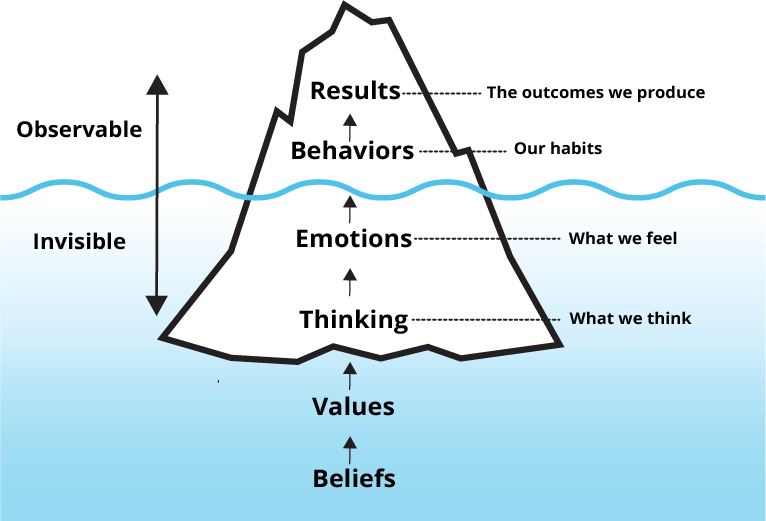Let’s address the elephant in the room – strategic planning impacts culture, and culture impacts strategic planning.
Strategy and culture have a relationship that can be hard to define. Strategy is structured and tangible, yet culture is very emotional and lofty. But make no mistakes, an organization relies on both to see success in strategy.
Why then do many leaders choose to ignore culture as part of strategic planning?
Before we talk about culture and strategy, let’s define what culture actually is.
A simple explanation of culture is made up of beliefs and behaviors. On the surface, culture is a representation of, “the way we do things around here.” It’s the consistent, observable patterns of behaviors within an organization.

But, as represented by this diagram, culture is comprised of so much more that actually resides below the surface and isn’t inherently observable. At the bottom of culture is beliefs – beliefs are what drives our behaviors and actions as an organizational culture. What we truly believe as an organization drives our behavior.
At OnStrategy, we believe that we keep score by our client’s successes. That means our client’s needs come first.
That belief is what drives our behavior. If one of our clients needs to make changes to their session agenda, strategic plan, or strategy management process, we move our internal deadlines and projects to meet the needs of our clients.
So, why does culture play such a huge part in strategic planning?
More often than not, organizations run headlong into some aspect of culture as they engage in the planning process. And, truth be told, many leaders simply avoid the culture conversation because it’s hard.
Strategic planning is more tangible. It’s structured, defines clear outcomes, and is something that can be clearly seen. Culture is different – it’s not as tangible and can be harder to clearly define because so much of what impacts organizational culture is below the surface (just like the earlier diagram). Because it is harder to grasp and isn’t as clear, many leaders simply avoid the topic of culture until they’re faced with an issue.
As we help our clients complete their strategic plans, many leaders begin to realize what a major role culture plays in strategy. We’ve adapted the following three common senarios from Connor and Smith’s Change the Culture, Change the Game:
“We are actually unsure of what our culture is.”
Sometimes leaders and organizations are simply unsure what defines their culture. We particularly see this happen with start-ups and early-stage organizations, but it isn’t always isolated to those situations.
Our recommendation: If you’re unsure what your culture actually is, it might be time to assess and observe what behaviors your organization exhibits and think about what beliefs drive those behaviors.
Our culture is shifting and it’s making us uneasy.
In any organization, change will always be a constant – and sometimes culture can be at the center of that change. In most cases, being uneasy about your organization’s culture shift means your team is exhibiting behaviors that aren’t a representation of your values.
Our recommendation: Think about the behaviors you see that don’t align to your values. What beliefs might be driving those behaviors? Realigning your culture to your values and behaviors you want to see will be driven by changing your team’s experiences. (We’ll be covering this topic in our next newsletter, so stay tuned.)
“We’re changing the direction of our organization, and that might impact our culture. We love our culture and want to preserve it.”
As we’ve stated, strategic planning will almost always have some impact on culture. For organizations who love their culture but are changing their direction, it takes careful consideration on how to maintain their culture during big strategic shifts.
Our recommendation: Consider how you can adapt and preserve your team’s behaviors and beliefs as you shift direction. How can your current belief system support your shifting business direction? Articulate it and keep it front-and-center during the planning process.
Culture as part of the planning process.
Our final recommendation is to not brush off the importance of culture during the planning process. It’s important as a leader to deal with culture head on. It’s a tough, emotional subject that might feel out of place during strategic planning.
Stay Tuned – Next newsletter, we’re going to cover breakdown between beliefs, behaviors, and experiences and how each impacts culture and culture shift.











